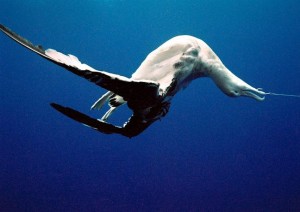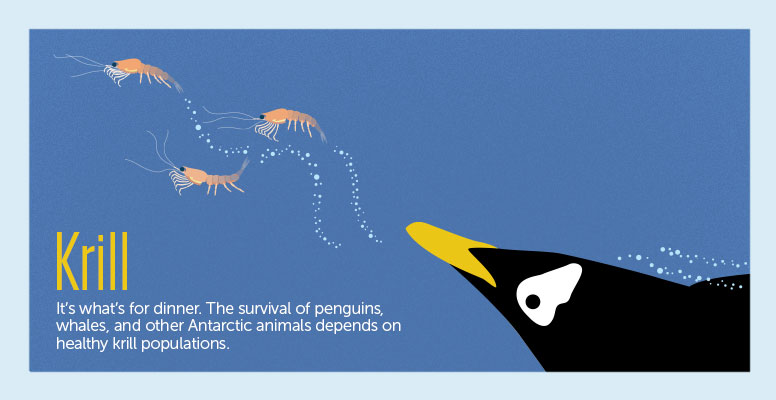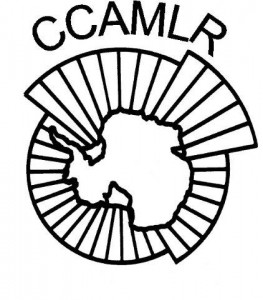 What is CCAMLR?
What is CCAMLR?
The world’s most pristine ocean is being threatened by climate change and commercial fisheries. For the sake of one of the last intact ecosystems, the Commission for the Conservation of Antarctic Marine Living Resources (CCAMLR) has been tasked with the conservation and management of Antarctic marine life and habitat since 1982. It is currently made up of 25 members from 24 countries and the European Union.
How does CCAMLR work?
Before CCAMLR members vote on issues, policies, and motions, they are advised by their Scientific Committee, which assesses fish population health, as well as ecosystem monitoring and management. There is also a committee that oversees implementation compliance with the commission’s decisions. The commission must come to a unanimous decision before any action can be taken.
The CCAMLR Scientific Committee uses ecosystem-based fisheries practices to manage its fish populations. This involves taking into consideration both ecosystem and human interactions when planning fisheries management. It is a much larger-scale picture compared to single species management.

Fisheries affect much more than fishers and their fish; they create numerous interactions between the environment and people. The marine habitat is a complex and diverse ecosystem affected by many physical, biological, and chemical processes and society is made up of many groups with different interests and goals. By understanding how the ecosystem works, fisheries management can become much more effective. (Image credit: Oceanecology)
At the 2002 World Summit on Sustainable Development (WSSD), a goal was set to achieve a representative network of Marine Protected Areas (MPAs) by 2012. In response to this, CCAMLR developed a conservation measure to guide MPA establishment in Antarctica based on the best available scientific evidence. Designation of an MPA in Antarctica would allow for the protection of marine ecosystems and their processes, biodiversity, and habitats, as well as the establishment of scientific reference areas.
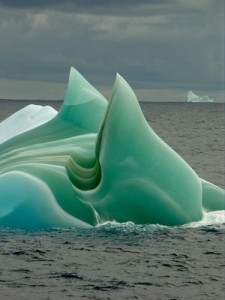
A rare sight of “Jade Icebergs” from Dr. Steve Nicol; usually the dark green ice is underwater, but here it is afloat.
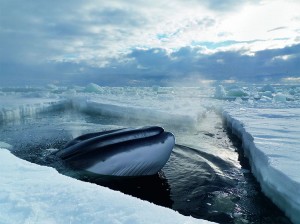
Courtesy of BBC Earth Frozen Planet, a majestic minke whale in the Ross Sea coming to the surface to breathe.
Why does CCAMLR exist? Why is it important?
Antarctica is home to over 10,000 species, many of which are endemic, meaning they can be found nowhere else on the planet. Two areas, known as the Ross Sea and the East Antarctic, are under consideration to become MPAs. The Ross Sea MPA would cover 1.32 million km2, down from the original proposal of over 2 million km2, while the East Antarctic MPA would protect 1.6 million km2.
Plans for the Ross Sea MPA were first blocked in 2011 by the Ukraine and Russia. International relations soured in 2013 with Edward Snowden’s asylum in Russia and again in March of this year with Russia’s annexation of Crimea. Although Ukraine backed Russia in 2011, with current political tensions, it is unclear how the CCAMLR negotiations will play out this year.
What does the Ross Sea policy proposal include?
New Zealand and the USA have proposed a 1.32 million km2 MPA, with a no-take zone of 1.25 million km2 (purple in the figure below) where no commercial harvesting would be allowed. The establishment of a Special Research Zone (light blue) would allow harvesting for scientific purposes only. The current fishing activities will be distributed to areas outside of the MPA, which will be determined by research so as to maintain a sustainable fishery.
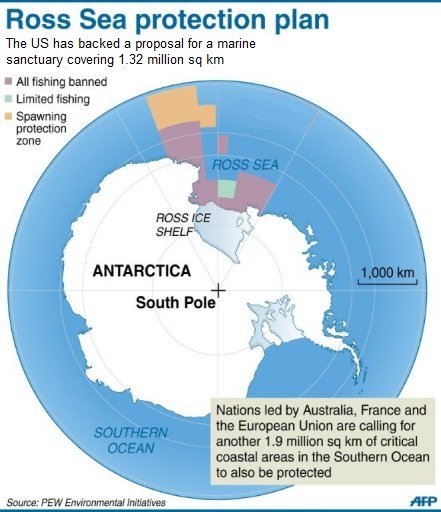
The Ross Sea MPA proposal can be found here.
But why Antarctica, you ask? Why should YOU care?
Often called The Last Ocean, the Ross Sea is considered to be the most pristine marine areas on Earth. As you can see below, Antarctic has experienced very little human impacts.
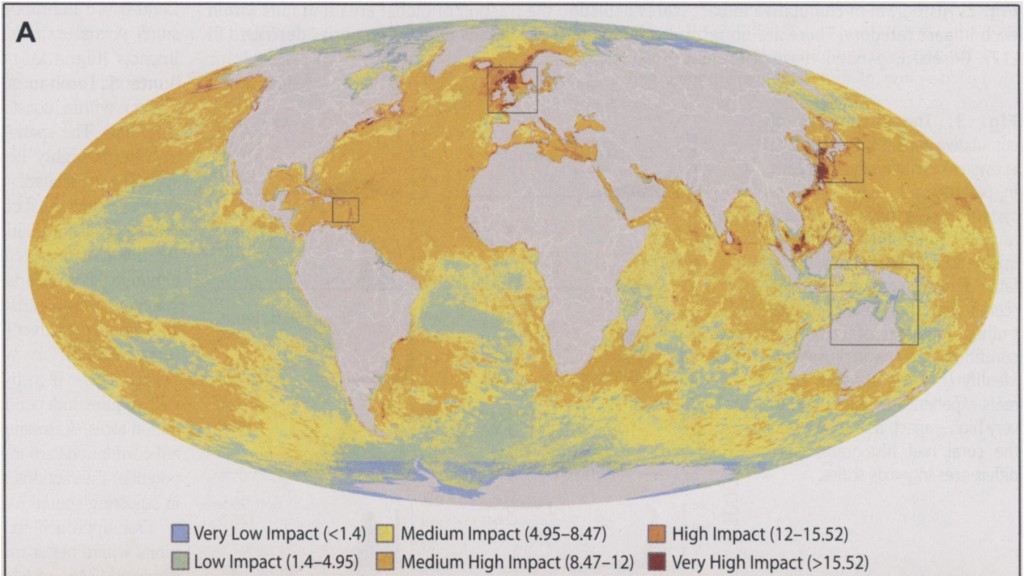
This map shows the intensity of human impacts in marine areas from high impacts (red) to low impacts (blue). Notice that Antarctica has experienced very low impact from humans, which is why it is still so pristine. Making the Ross Sea an MPA would allow CCAMLR to maintain the beauty and life of the area. (From Halpern et al 2008)
If that isn’t enough to persuade someone of the importance of conserving this area, then you may be interested to know that the Antarctic krill population is used in pharmaceuticals and nutraceuticals, which are products and supplements that keep humans healthy.
How has CCAMLR been successful?
In the 1990s, the rapidly developing Antarctic longline fishery resulted in a high quantity of seabird bycatch, meaning that seabirds were being entangled by mistake. This was detrimental to seabird populations in the region, especially albatross and petrel.
CCAMLR created a group to annually study seabirds (excluding penguins and other coastal bird species) and fish stocks in existing and potential fishery areas. Their analyses resulted in major preventative measures that successfully worked to reduce seabird bycatch. This method and approach indicates that the proposed MPAs can be effectively managed by CCAMLR without major disruptions to fisheries in these areas.
What’s next for CCAMLR policy?
- CCAMLR has yet to determine the course of action regarding the management of krill fisheries. The sheer abundance of the crustacean makes it one of the largest protein sources on Earth, utilised by fish, penguins, whales, and, of course, humans.
- Aquaculture is a major driving force in expanding this fishery with fish farms globally becoming reliant upon krill-based fish feed. Enzymes and chemicals derived from krill are also coming to the fore in medicinal products.
- The changing environment is also impacting krill populations. Their numbers have declined by 80% since 1970 in the Southern Ocean, as their algal prey have dwindled around the Antarctic Peninsula.
- CCAMLR is currently meeting to determine the management practice to preserve this ecologically and economically vital fishery. They must protect from overexploitation of certain areas and crucial spawning grounds whilst maintaining economic interests. This is a challenge that must be met with conviction to preserve a final frontier of our oceans.
To sign a petition supporting CCAMLR please visit: http://antarcticocean.org/
How to contact the blog authors on Twitter:
Toby Buttress (@toby_buttress)
Shannon Keefe (@shannonkeefe333)
Josephine Ling (@josephinejling)
Jeremy Mayer (@jeremymayer5)
Kate McGivney (@katemcgivney)
Kelsey Webb (@kelseywebbratz)
References
Commission for the Conservation of Marine Living Resources. (2011). General framework for the establishment of CCAMLR Marine Protected Areas. (Conservation Measure 91-04). Hobart, Tasmania: CCAMLR-XXX.
Fabra, A., & Gascon, V. (2008). The Convention on the Conservation of Antarctic Marine Living Resources (CCAMLR) and the Ecosystem Approach. The International Journal of Marine and Coastal Law, 23(3), 567-571.
Halpern, B.S., Walbridge, S., Selkoe, K.A., Kappel, C.V., Micheli, F., Agrosa, C.,…Watson, R. A. (2008). Global Map of Human Impact on Marine Ecosystems. Science, 319, 948-952.
Marine, M. (2010). Ecologists fear Antarctic krill crisis. Nature, 467, 2.
Miller, D.G.M., Sabourenkov, E.N., & Rarnm, D.C. (2004). Managing Antarctic Marine Living Resources: The CCAMLR Approach. The International Journal of Marine and Coastal Law, 19(3), 317-363.
Sherirff, N. (2014, Oct 17). East-West hostility may stall Ross Sea conservation. Aljazeera America. Retrieved from http://america.aljazeera.com/articles/2014/10/17/environmentalistsfeareastwesthostilitymaystallrossseaconservatio.html
Vincent, A. (2014). CCAMLR, EBM and the Ross Sea [PowerPoint slides]. Retrieved from UBC Connect <http://elearning.ubc.ca/connect/>.
Waugh, S., Baker, G., Gales, R., & Croxall, J. (2008). CCAMLR process of risk assessment to minimise the effects of longline fishing mortality on seabirds. Marine Policy, 32, 442-454.
